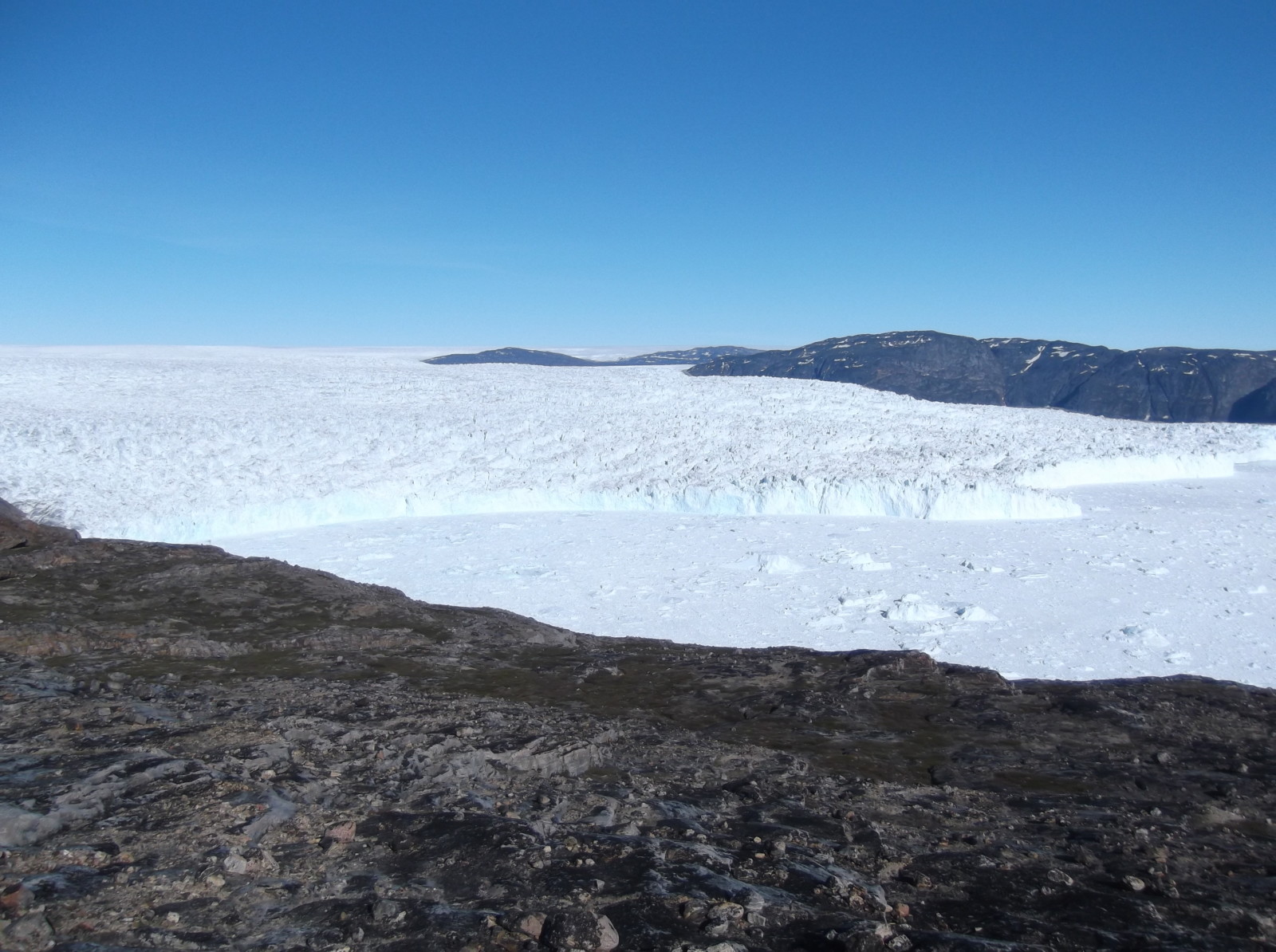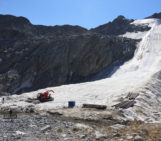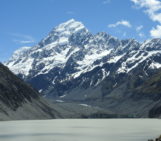
A practical illustration of albedo at Store Glacier, Greenland (the big shiny white thing) [Credit : Samuel Cook]
Albedo or albedon’t? One possible solution to global warming is to turn everything white to increase the planet’s albedo, i.e. how reflective it is (see, for example, this website). A higher albedo would be one way to reduce global warming, by reducing the amount of incoming shortwave solar radiation absorbed by the planet’s surface, which is then re-emitted as longwave radiation that can be trapped by greenhouse gases in the atmosphere. This would hypothetically allow us to compensate for the loss of cryospheric land cover (ice sheet, glaciers, sea ice, snow, …) at the Earth’s surface. Indeed the ice-albedo feedback is a key driver of deglaciation (ice melts, exposing bare, dark rock or water, which absorbs more heat from the sun, which melts more ice…).
This isn’t a good idea, right?
At first glance, it seems a little eccentric. Especially when you come to the logical conclusion that anyone with dark hair should go around wearing hats made of loo roll. Or come up with the interesting hypothesis that the Ku Klux Klan were unexpectedly environmentally progressive. And, indeed, yes, covering large areas of vegetation in white is pretty counter-productive. For a start, you’ll kill all the vegetation, which will put a serious dent in any plans you might have to combat global warming, by reducing carbon uptake and also releasing a whole new lot of it from all the decaying plant matter.
Hang on, are you sure?
But, is this true in all cases? What about if we only painted artificial surfaces white, such as roofs, roads, pavements, and so on? About 1% of the planet’s total surface area is urbanised or covered with various bits of human infrastructure that we could perhaps paint white. The albedo of the most extensive manmade surfaces – asphalt, concrete, etc. – is generally 0.4 or lower. In other words, they reflect 40% or less of the incoming solar radiation. The albedo of white acrylic paint is about 0.8, so painting all our cities and roads white would, roughly, double the albedo of that 1% of the planet’s surface. Which would equate to, roughly again, a 1% increase in the planet’s average surface albedo, which currently stands at ~0.3[1].
The solar constant at the top of the atmosphere, i.e. how much energy the sun is inputting to the Earth system, is 1368 W/m². By the time you get to the surface, it’s more like 1000 W/m². So, brightening the surface of the planet by 1% would lead to an extra 10 W/m² being reflected before it could contribute to global warming. This might not sound like much, but, locally, this would probably make a fair difference. This article suggests that a change in albedo of 0.1 brought about by a change in land cover (which would be effectively what would be happening here) leads to about 2 degrees of cooling. So, an increase of >0.4 in albedo in urban areas would be a good way of reducing the urban heat island effect and making cities more liveable in a warming world (as is already being pioneered, for example, in Los Angeles). On a planetary scale, though, it’s less clear. Generally speaking, it’s thought that a 2% increase in albedo would about half the warming effects of a doubling in carbon dioxide concentrations. So, painting everything white might actually not be as outré as it seems at first.… And, indeed, various ski resorts or tourism bodies have tried things such as covering their glaciers in white matting on exactly this principle. Though any such venture is much too small-scale to really make a difference – the warmer air will still melt the ice.
OK, it’s only mostly not a good idea.
But, it’s still a terrible idea. Firstly, imagine the glare! Every time a city dweller went outside, they’d be blinded. Traffic accidents would skyrocket as motorists were either also blinded or had to wear shades so dark, they couldn’t see the road. We’d all be really tanned, though…. On a more sensible level, there’s the question of the environmental consequences of producing all that paint and having to apply it – one suspects they’re not negligible. But the real issue is that it’s not dealing with the problem – greenhouse gas levels would still be high, we’d still be burning fossil fuels, the oceans would still be acidifying and so on. If we got fed up of white, then temperatures would start to climb rapidly again. This is one of the main arguments against these solar radiation management mitigation strategies for global warming – they only treat the symptoms. It’s equivalent to taking some painkillers when you have a cold – sure, you feel better for a bit, but you still have a cold. Or, in this case, a fever.

I think the world would look very pretty in ‘Magic White’, don’t you? [Credit: Dulux]
At least painting everything white is probably better than chucking a load of sulphate aerosols into the atmosphere, which is essentially the same idea, but on a bigger scale. It would work, but I hope we all really like acid rain…. That’s why all these versions of geoengineering are very much a last resort – they’re better than nothing, but, if we have to use them, we’ve really messed up. The old adage of a stitch in time saves nine is particularly applicable here.
So, there you have it, painting everything white as a solution to global warming is silly, but probably not for the reasons you thought in the first place. Though, it is a good idea for mitigating extra local warming in the urban milieu. And, to return to a purely cryospheric point of view, it would help save all the ice. As long as you don’t mind the Polar regions all smelling like the Dulux aisle in your favourite hardware store. For ever.
[1] Strictly speaking, this is the top-of-atmosphere albedo. But, to make things simpler, I’m just going to assume it’s all fungible and that this 0.3 value is getting increased by 1%. For reference, the oceans have low albedos of <0.1 and forests and bare ground typically fall in the 0.1-0.2 range, but the number gets boosted by clouds, which are really reflective. Here, I’m just assuming that cloud cover isn’t going to change significantly from its average, because that would make things complicated. The actual surface albedo of the planet, though, is probably about 0.14.
Edited by Violaine Coulon
 Samuel Cook is a postdoctoral researcher at Université Grenoble-Alpes. He recently completed a PhD at the University of Cambridge on numerical modelling of tidewater glaciers and is currently developing the use of data-assimilation methods in the Elmer/Ice numerical modelling suite as part of the MAGIC project.
Samuel Cook is a postdoctoral researcher at Université Grenoble-Alpes. He recently completed a PhD at the University of Cambridge on numerical modelling of tidewater glaciers and is currently developing the use of data-assimilation methods in the Elmer/Ice numerical modelling suite as part of the MAGIC project.
Contact Email: samuel.cook@univ-grenoble-alpes.fr



